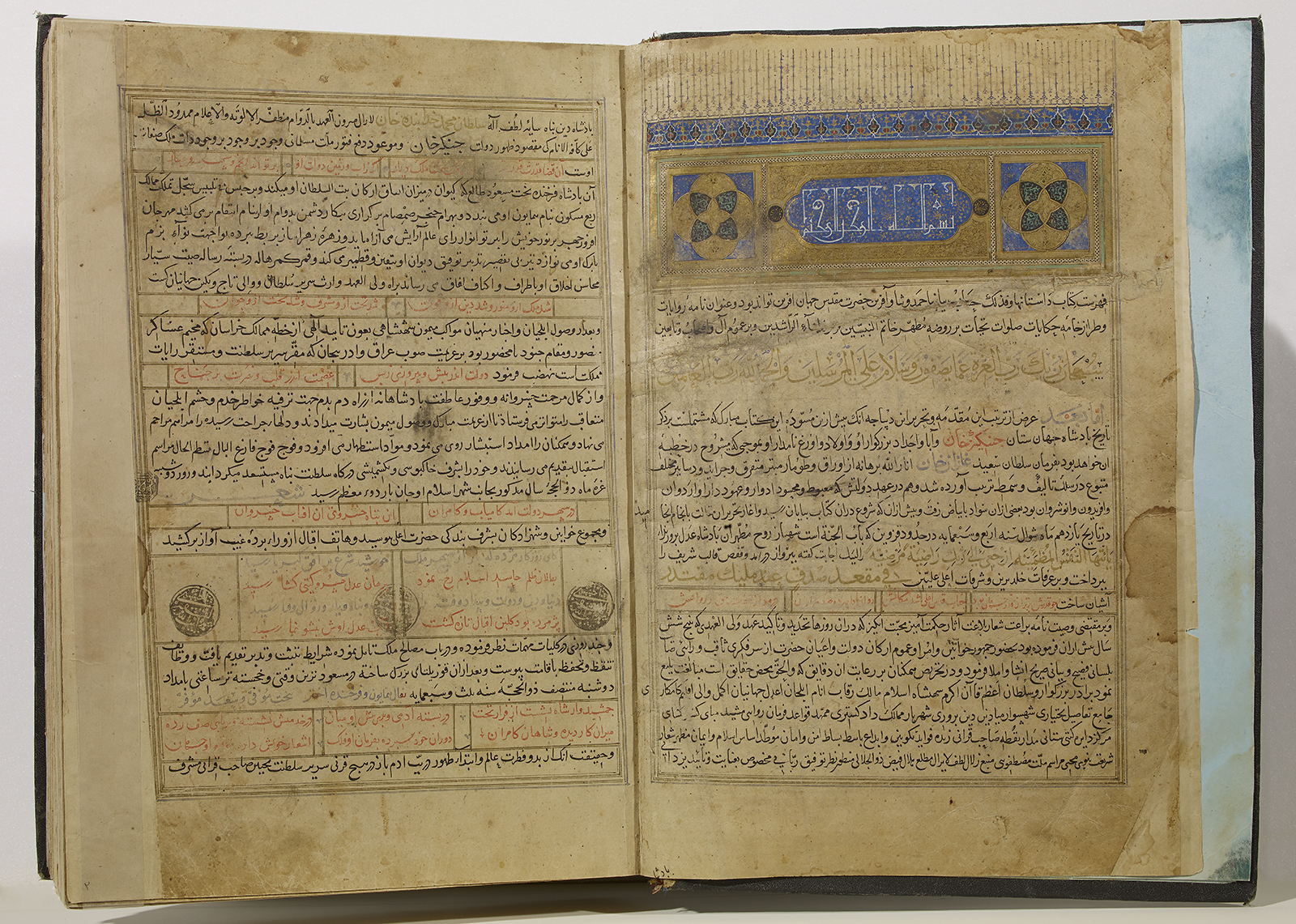Click on the image to zoom
Jami’ al-tavarikh: Tarikh-I Mubarak-I Ghazani (The blessed History of Ghazan) By Rashid al-Din Fazlullah (d.1318)
- Accession Number:AKM517
- Place:Iran or Afghanistan
- Dimensions:37 × 27 cm
- Date:late 14th or early 15th c.
- Materials and Technique:Ink, opaque watercolour, and gold on paper; bound in cloth
Tarikh-i mubarak-i Ghazani (The Blessed History of Ghazan) is an invaluable source for the early history of the Mongol Empire. Begun in 1302 by Rashid al-Din,[1] doctor and vizier to Ilkhanid rulers Ghazan Khan (r. 1295–1304) and his brother Öljeitü Sultan (r. 1304–16), it draws from various scrolls, books, records, and memories preserved by members of the Mongol military elite to tell the story of the Mongol royal family from its legendary ancestors to Ghazan Khan. Ghazan had converted to Islam, and his identity as a Muslim was an important component of his political ideology. Accordingly, The Blessed History shows the Mongol conquest (which had ended the ʿAbbasid caliphate) and the reign of Ghazan as the salvation of Islamic civilization, rather than its apocalyptic end. The Aga Khan Museum’s copy of The Blessed History was made almost a century after Rashid al-Din wrote the work, but it is one of the most complete and important surviving copies of the text.
Further Reading
The Blessed History of Ghazan begins with a description of the Turkic and Mongol tribes that constituted Genghis Khan’s empire. Rashid al-Din distinguishes himself from earlier writers who had described the nomads of Inner Asia as a monstrous race, often associating their invasion with an imminent apocalypse. He instead ties the Mongols into a historical model of the human community that was familiar to the Muslim, Christian, and Jewish populations of the Middle East: he identifies the Turks and Mongols with one branch of a human family going back to Noah, whose descendants were said to have spread out over the earth to repopulate it after the deluge.[2]
Genealogy remains important for the entire Blessed History of Ghazan. Throughout the work, Rashid al-Din uses visual genealogical trees to show the relationship between each Mongol ruler and the generations that succeeded him.[3] For the descendants of Genghis Khan, these genealogical trees could grow quite large, sometimes covering multiple pages. One such page survives in this manuscript (folio 170a), showing part of the family of Genghis Khan’s oldest son, Jochi, whose descendants ruled western Eurasia from their capital on the lower Volga River.
This manuscript in the Aga Khan Collection was probably made at a regional court of the young Timurid state. The opening illumination resembles others produced in Baghdad, Herat, and Shiraz in the late 14th and early 15th centuries.[4] Amir Timur’s son and successor, Shahrukh (d. 1447), who ruled from Herat, took a particular interest in the scholarship of the Ilkhanid period, and this manuscript may have been part of this renewed interest in Rashid al-Din’s work. It was copied from a manuscript now in Tashkent (Abu Rayhon Biruni Institute ms. 1620), which was probably written during Rashid al-Din’s lifetime and under his supervision.[5] Unusually for a Persian manuscript, this copy has been bound in cloth. It is covered with a paisley tweed, probably of goat hair and likely produced in Kerman around 1840.[6]
— Stefan Kamola
Notes
[1] On Rashid al-Din’s life and career, see Kamola, “Rashīd al-Dīn.” On his patronage of book production, see Ben Azzouna, “Rashīd al-Dīn Faḍl Allah.”
[2] See Kamola, “History and Legend,” 565–67 for a discussion of how Rashīd al-Dīn ties the Mongols into a historical model of the human community that was familiar to the Muslim, Christian, and Jewish populations of the Middle East.
[3] For a discussion of the genealogical tree and its functions, see Binbaş, “Structure and Function,” 485–99.
[4] See Wright, The Look of the Book, 48–105 for a discussion and examples of illumination produced in Baghdad, Herat, and Shiraz in the late 14th and early 15th centuries.
[5] Later, the first 168 folios of another manuscript, now in Mashhad (Astan-i Quds ms. 4101), were copied from the AKM manuscript. That manuscript, along with the Tashkent manuscript, have been used by various scholars and editors of The Blessed History, since they contain a very correct text. Given that AKM517 is directly related to both of them and is more complete than either (only five folios are missing), it offers a valuable textual witness for this most important Mongol history.
[6] As noted by Jeff Spurr, a specialist in Middle Eastern textiles, in personal correspondence.
References
Ben Azzouna, N., “Rashīd al-Dīn Faḍl Allah al-Hamadhānī’s Manuscript Production Project in Tabriz Reconsidered,” Politics, Patronage and the Transmission of Knowledge in 13th-15th Century Tabriz, ed. J. Pfeiffer, Leiden, 2014. ISBN: 9789004255395
Binbaş, İ.E., “Structure and Function of the Genealogical Tree in Islamic Historiography,” Horizons of the World: Festschrift for İsenbike Togan, ed. İ.E. Binbaş and N. Kılıç-Schubel, Istanbul, 2011, 465–544. ISBN: 9786053751601
Blair, Sheila, Rashīd al-Dīn’s A Compendium of Chronicles: Rashid al-Din’s Illustrated History of the World, London, 1995. ISBN: 9780197276273
Kamola, S., “Rashīd al-Dīn and the Making of History in Mongol Iran,” Ph.D. Dissertation, 2013.
Kamola, S., “History and Legend in the Jāmiʿ al-tawārīkh: Abraham, Alexander, and Oghuz Khan,” Journal of the Royal Asiatic Society 25.4 (2015), 555–77. DOI: 10.1017/S1356186315000218
Thackston, W., Rashiduddin Fazlullah’s Jami’u’t-Tawarikh = Compendium of Chronicles, Cambridge, MA, 1998.
Wright, E., The Look of the Book: Manuscript Production in Shiraz, 1303–1452, Washington, 2012. ISBN: 9780295991917
Note: This online resource is reviewed and updated on an ongoing basis. We are committed to improving this information and will revise and update knowledge about this object as it becomes available.


